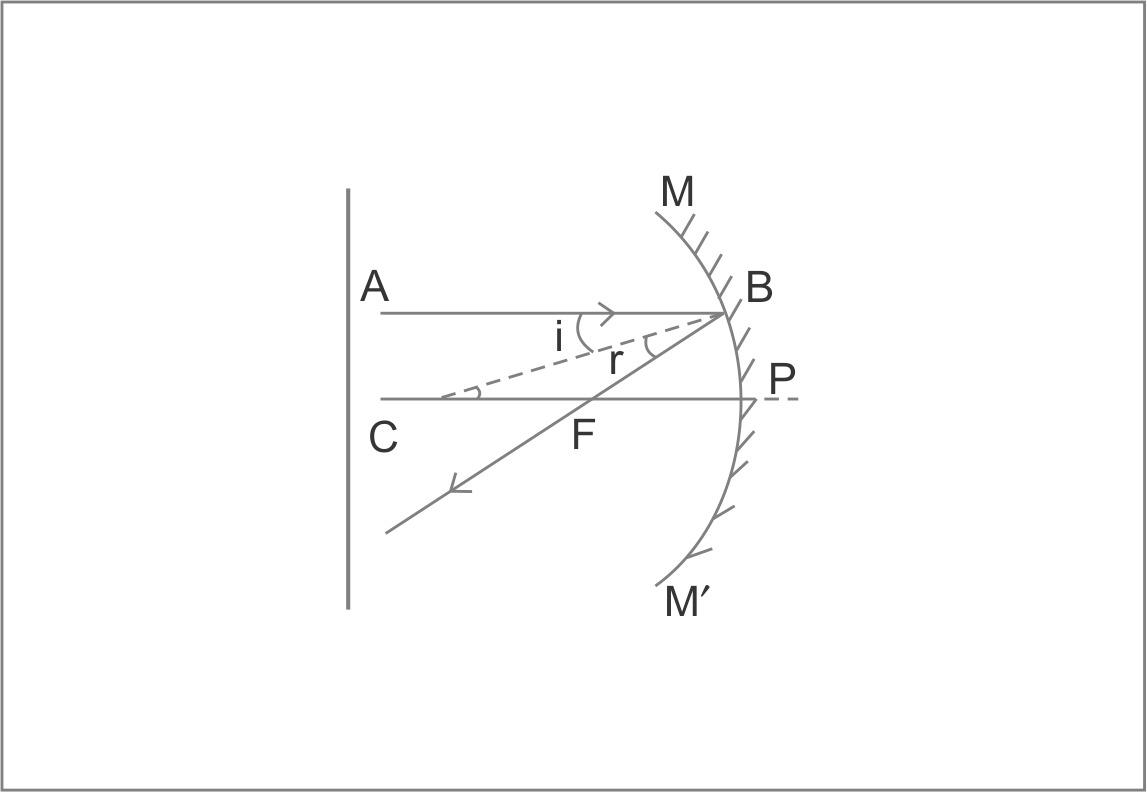
Radius of curvature of spherical mirror is:
A) Half of focal length
B) Double of focal length
C) Equal to focal length.
D) No relation.
Answer
218.4k+ views
Hint: In this as we know that the spherical lens is a part of a spherical mirror. The relation between focal length of a spherical lens and the radius of a spherical lens is calculated by understanding the sign convention.
Complete step by step answer:
As we know that the center of a spherical mirror or the lens is known as the center of curvature of that mirror or lens. The radius of a spherical mirror or lens is defined as the distance between the centre of curvature to the circumference of the curvature.
The figure below represents the sketch diagram of a curved surface (mirror or lens).

As we can see in the above figure $CP = CB$. These both distances are the radius of the mirror.
From the geometry of the Figure it is clear that,
$ \Rightarrow BF = PF$
Further we can conclude that,
$ \Rightarrow FC = FP$
Also,
$ \Rightarrow FP = PF$
From the diagram we can write that,
$ \Rightarrow PC = PF + FC$
Now we substitute $PF$ for $FC$ in above equation.
$PC = PF + PF$
After simplification we get,
$ \Rightarrow R = 2PF$
Now substitute $f$ for$PF$ in above equation to get
$\therefore R = 2f$
Here, $f$ is the focal length of the spherical lens.
It is clear from the above expression that the radius of curvature of a spherical lens is twice the focal length of the lens.
Therefore, the correct option is (B).
Note: In this question the diagram of the spherical lens should be made clear and the basic knowledge of geometry is applied. The main concept in this question is substitution of various data (distance) from the diagram. If this substitution goes wrong the answer will be wrong.
Complete step by step answer:
As we know that the center of a spherical mirror or the lens is known as the center of curvature of that mirror or lens. The radius of a spherical mirror or lens is defined as the distance between the centre of curvature to the circumference of the curvature.
The figure below represents the sketch diagram of a curved surface (mirror or lens).

As we can see in the above figure $CP = CB$. These both distances are the radius of the mirror.
From the geometry of the Figure it is clear that,
$ \Rightarrow BF = PF$
Further we can conclude that,
$ \Rightarrow FC = FP$
Also,
$ \Rightarrow FP = PF$
From the diagram we can write that,
$ \Rightarrow PC = PF + FC$
Now we substitute $PF$ for $FC$ in above equation.
$PC = PF + PF$
After simplification we get,
$ \Rightarrow R = 2PF$
Now substitute $f$ for$PF$ in above equation to get
$\therefore R = 2f$
Here, $f$ is the focal length of the spherical lens.
It is clear from the above expression that the radius of curvature of a spherical lens is twice the focal length of the lens.
Therefore, the correct option is (B).
Note: In this question the diagram of the spherical lens should be made clear and the basic knowledge of geometry is applied. The main concept in this question is substitution of various data (distance) from the diagram. If this substitution goes wrong the answer will be wrong.
Recently Updated Pages
A square frame of side 10 cm and a long straight wire class 12 physics JEE_Main

The work done in slowly moving an electron of charge class 12 physics JEE_Main

Two identical charged spheres suspended from a common class 12 physics JEE_Main

According to Bohrs theory the timeaveraged magnetic class 12 physics JEE_Main

ill in the blanks Pure tungsten has A Low resistivity class 12 physics JEE_Main

The value of the resistor RS needed in the DC voltage class 12 physics JEE_Main

Trending doubts
JEE Main 2026: Application Form Open, Exam Dates, Syllabus, Eligibility & Question Papers

Derivation of Equation of Trajectory Explained for Students

Hybridisation in Chemistry – Concept, Types & Applications

Understanding the Angle of Deviation in a Prism

Understanding Collisions: Types and Examples for Students

Understanding Atomic Structure for Beginners

Other Pages
JEE Advanced Marks vs Ranks 2025: Understanding Category-wise Qualifying Marks and Previous Year Cut-offs

How to Convert a Galvanometer into an Ammeter or Voltmeter

Understanding Centrifugal Force in Physics

JEE Main Marking Scheme 2026- Paper-Wise Marks Distribution and Negative Marking Details

Degree of Dissociation: Meaning, Formula, Calculation & Uses

Understanding Electromagnetic Waves and Their Importance




